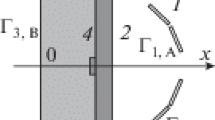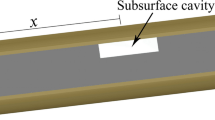Abstract
In the study of improving the forging quality and the defects repairing technology, the recognition of the cavities and large cracks inside heavy forgings is a key factor. To quickly acquire the geometric parameter information of the cavities and larger cracks inside heavy forgings, firstly, based on the heat conduction theory and the cavity closure theory, a series of cavities and larger cracks are analyzed and studied. Using the three-dimensional ellipsoid model and the symbolic function, the boundary model of the cavities and large cracks inside heavy forgings is constructed. Secondly, utilizing the homogenization method of equivalent thermal resistance, the thermal conductivity is modified. And the temperature field model of heavy forgings containing the internal cavities is established. Meanwhile, the defect information of position and size is obtained and it is considered as the initial recognition condition. Thirdly, combining the temperature field and the initial boundary, the boundary recognition model of the cavities is constructed based on the recursive search method. This model is utilized to further obtain the boundary information of the forging defects. Finally, utilizing the infrared temperature measurement experimental platform and the Software COMSOL, the feasibility of the temperature field model and the cavities boundary recognition model for forging is verified. Utilizing the combination of analytical solutions and numerical solutions, the two models can be used to obtain the geometric parameters information of defects inside heavy forgings. They are significant for improving the forging quality and the defects repair.
Similar content being viewed by others
References
Giedt WH (1955) The determination of transient temperatures and transfer at a gas-metal Interface applied to a 40-mm gun barrel. JetPropulsion 25(4):158–162
Hadamard J (1923) Lectures on Cauchy’s problem in linear differetial equation. Yale University Press, New Haven
Tikhonov AN, Arsenin VY (1977) Solution of ill-posed promblems. Wiston and Sons, Washington
Beck JV, Blackweell B, Clair CR (1985) Inverse heat condition: ill-posed promblems. Weil Interscience, New York
Alifanov OM, Tryanin AP (1985) Determination of the coefficient of internal heat exchange and the effective thermal conductivity of a porous solid on the basis of a nonstationary experiment. J Eng Phys 48(3):356–365
Akramin MRM, Ariffin AK, Kikuchi M, Abdullah S (2017) Sampling method in probabilistic S-version finite element analysis for initial flaw size. J Braz Soc Mech Sci Eng 7(39):357–365. https://doi.org/10.1007/s40430-016-0549-z
Seko Y, Imai Y, Mitsuya M, Oguchi N, Minami F (2016) Brittle fracture assessment of embedded flaw in heat-affected zone based on Weibull stress criterion. Welding World 9(6):837–846. https://doi.org/10.1007/s40194-016-0344-6
Hawryluk M, Ziemba J (2017) Possibilities of application measurement techniques in hot die forging processes. Measurement 11(110):284–295. https://doi.org/10.1016/j.measurement.2017.07.003
Muñoz S, Anselmi-Tamburini U (2013) Parametric investigation of temperature distribution in field activated sintering apparatus. Int J Adv Manuf Technol 65:127–140. https://doi.org/10.1007/s00170-012-4155-7
Dutta A, Gupta AK, Mishra G, Chhabra RP (2018) Effect of fluid yield stress and of angle of tilt on natural convection from a square bar in a square annulus. Comput Fluids 160:138–163. https://doi.org/10.1016/j.compfluid.2017.10.020
Udayraj TP, Das A, Alagirusamy R (2016) Ramasamy Alagirusamy. Simultaneous estimation of thermal conductivity and specific heat of thermal protective fabrics using experimental data of high heat flux exposure. Appl Therm Eng 25(107):785–796. https://doi.org/10.1016/j.applthermaleng.2016.07.051
Liberini M, Scherillo F, Astarita A, Prisco U, Bruno M, Monetta T, Bellucci F, Squillace A (2016) Squillace-Microstructure of a hot forged Ti5-5-5-3 aeronautical component. MetalloGr Microst Anal 5(3):207–216. https://doi.org/10.1007/s13632-016-0278-9
Astarita A, Testani C, Scherillo F, Squillace A, Carrino L (2014) Beta forging of a Ti6Al4V component for aeronautic applications: microstructure evolution. Metal, Microstruct, and application and innovation for metals, alloys, and engineered materials. Metallogr Microstruct Anal 3(6):460–467. https://doi.org/10.1007/s13632-014-0171-3. ISSN 2192-9262
Zhong Y, Xiao FR, Shan Y, Yang K (2005) Study of relationship between fatigue crack growth rate and fatigue life for pipeline steels. Acta Metall Sin 41(5):523–528
Zhang ZF, Wang ZG, Shi CX (2004) Intergranular fatigue cracking mechanisms. J Sch Chin Acad Sci 21(4):270–275
Cui M, Yang K, Liu YF, Gao XW (2012) Inverse estimation of transient heat flux to slab surface. J Iron Steel Res Int 19(11):13–18. https://doi.org/10.1016/S1006-706X(13)60014-X
Yang BG, Liu SB (2016) Closed-form analytical solutions of transient heat conduction in hollow composite cylinders with any number of layers. Inter J H M Tran 108(2017):907–917. https://doi.org/10.1016/j.ijheatmasstransfer.2016.12.020
Wang FF, Man QX, Meng W, Han ZQ (2017) Experimental study on the heat transfer behavior and contact pressure at the casting-mold interface in squeeze casting of aluminum alloy. Inter J H M Tran 112:1032–1043. https://doi.org/10.1016/j.ijheatmasstransfer.2017.05.051
Zhang YC, Fu XB, Zhang FL (2015) Temperature field detection model based on the dimensional change during the thermal forging process [J]. Appl Therm Eng 81:168–176. https://doi.org/10.1016/j.applthermaleng.2015.02.015
Zhang SH, Chen XD, Zhou J, Zhao DW, Wang XY (2016) A dynamic closure criterion for central defects in heavy plate during hot rolling. Meccanica 10(51):2365–2375. https://doi.org/10.1007/s11012-016-0371-9
Fu XB, Liu B, Zhang YC (2013) Measurement technology of the hot-state size for heavy shell ring forging[J]. Int J Adv Manuf Technol 65(1–7):543–548. https://doi.org/10.1007/s00170-012-4193-1
Zhang YC, Han JX, Fu XB, Lin HB (2014) An online measurement method based on line laser scanning for largeforgings. Int J Adv Manuf Technol 70:439–448. https://doi.org/10.1007/s00170-013-5240-2
Zhou S, Zhang YC, Fu XB (2013) Inner wall running state monitoring for the main pip of nuclear power [J]. Sci China Technol Sci 56(10):2606–2614. https://doi.org/10.1007/s11431-013-5332-0
Zhang LQ, Zhang YC, Fu XB (2015) Analyses of interior temperature field distribution for hot axial forgings with void. China Mech Eng 26(15):2672–2675. https://doi.org/10.3969/j.issn.1004-132X.2015.19.020
Zhang XX, Cui ZS. (2009) Theoretical study of void closure in nonlinear plastic materialsm. App math and Mech (English edition) 05, ISSN:0253–4827
Luo XC, Yang Z (2017) A new approach for estimation of total heat exchange factor in reheating furnace by solving an inverse heat conduction problem. Inter J H M Tran 112:1062–1071. https://doi.org/10.1016/j.ijheatmasstransfer.2017.05.009
Magnini M, Thome JR (2017) An updated three-zone heat transfer model for slug flow boiling in microchannels. Inter J Multi F 91:296–314. https://doi.org/10.1016/j.ijmultiphaseflow.2017.01.015
Niu T, Liu JS (2009) Experimental study on the thermal conductivity of 45 steel in static contact. Mech Eng Auto 2:114–118
Acknowledgements
This study is supported by the National Natural Science Foundation of China (Grant No. 51505381, 51275423).
Author information
Authors and Affiliations
Corresponding author
Rights and permissions
About this article
Cite this article
Zhang, F., Yuan, Z., Dong, S. et al. The study of the cavity inside heavy forgings based on the temperature field detection model. Int J Adv Manuf Technol 99, 595–611 (2018). https://doi.org/10.1007/s00170-018-2442-7
Received:
Accepted:
Published:
Issue Date:
DOI: https://doi.org/10.1007/s00170-018-2442-7




